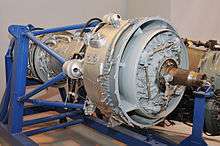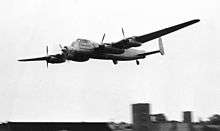Rolls-Royce Tyne
The Rolls-Royce RB.109 Tyne is a twin-shaft turboprop engine developed in the mid to late 1950s by Rolls-Royce Limited. It was first test flown during 1956 in the nose of a modified Avro Lincoln.[1] Following company naming convention for gas turbine engines this turboprop design was named after the River Tyne.
| Tyne | |
|---|---|
 | |
| Rolls-Royce Tyne installed in a Luftwaffe C-160 | |
| Type | Turboprop |
| Manufacturer | Rolls-Royce Limited |
| First run | April 1955 |
| Major applications | Breguet Atlantic Canadair CL-44 Transall C-160 Vickers Vanguard |
Design and development
Designed in 1954 by a team under Lionel Haworth and intended as a more powerful alternative to the Dart, the RB.109 Tyne was initially designed for a power of 2,500 shp but when first run in April 1955 the engine far exceeded expectations and was soon being type-tested at 4,220 shp.[2] The Tyne was developed primarily for the four-engined Vickers Vanguard airliner, the prototype first flying on 20 January 1959 equipped with four Tyne Mk.506 of 4,985 e.s.h.p.[3] Production deliveries of the engine were made from mid-1959 onwards to power the 43 Vanguards delivered to British European Airways and Trans-Canada Airlines.
The engine was further developed with greater power and used in the later twin-engined Dassault-Breguet Atlantique long-range reconnaissance aircraft; also in the Canadair CL-44 and Transall C-160 transport aircraft.
A single stage HP turbine drives the nine-stage HP compressor. A three-stage LP turbine drives the six-stage LP compressor and, through a reduction gearbox, the propeller. The combustor is cannular.
The Mark 515 Tyne had a nominal takeoff power output of 5,730 hp (4,273 kW) equivalent power, flat rated to ISA+16.8C.
An agreement was signed in 1963 between Hispano-Suiza and Rolls-Royce for the licence production of the Tyne for the Breguet Atlantic and Transall C-160.[4] Each company that was part of the agreement built parts for itself and the partners, Rolls-Royce (United Kingdom) 20%, Hispano-Suiza (France) 44%, MAN (Germany) 28% and FN (Belgium) 8%.[4] The final assembly was undertaken by both MAN and Hispano-Suiza.[4] The first production batch was for 80 engines and 40 spares for the Atlantic.[4]
Variants

- RTy.1
- 4,370 hp (3,259 kW) fitted to Vickers Type 951 Vanguard and Vickers Merchantman.
- RTy.11
- 5,064 hp (3,776 kW) for Vickers Type 952 Vanguard
- RTy.12
- 4,616 hp (3,442 kW) for Canadair CL-44
- RTy.12
- 5,399 hp (4,026 kW) for Short Belfast.
- RTy.20 Mk 21
- 5,667 hp (4,226 kW) for Breguet 1150 Atlantic and Breguet ATL2 Atlantique
- RTy.20 Mk 22
- 5,670 hp (4,228 kW) for Transall C-160
- RTy.20
- 4,860 hp (3,624 kW) for Aeritalia G.222T
- RTy.20
- 6,035 hp (4,500 kW) for Transall C-160 and Breguet ATL2 Atlantique
- RTy.22
- projected military use engine rated at 7,075 hp (5,276 kW) equivalent
- RTy.32
- projected military use engine rated at 8,400 hp (6,264 kW) equivalent
- Mk.101
- (RTy.12)
- Mk.506
- Mk.512
- Mk.515
- Mk.515-101W
- Mk 801
- Mk 45
- RM1A
- Marinised ship powerplant
- RM1C
- Essentially similar to the RM1A
- RM3C
- Essentially similar to the RM1A
Applications
Aircraft

- Aeritalia G.222
- Avro Lincoln (testbed)
- Breguet Atlantic
- Canadair CL-44
- Conroy Skymonster
- Short Belfast
- Transall C-160
- Vickers Vanguard
Engines on display
A Rolls-Royce Tyne is on public display at the Royal Air Force Museum Cosford.
- East Midlands Aeropark
Specifications (Tyne RTy.20 Mk 21)
Data from Jane's All the World's Aircraft 1962-63.[6]
General characteristics
- Type: Twin-spool turboprop
- Length: 108.724 in (2,762 mm)
- Diameter: 55.12 in (1,400 mm)
- Dry weight: 2,391 lb (1,085 kg)
Components
- Compressor: Axial, six-stage LP, nine-stage HP
- Combustors: 10 cannular flame tubes
- Turbine: Three-stage LP, single-stage HP
- Fuel type: Avtur
- Oil system: Pressure spray/splash with dry sump using DERD 2487 spec. oil
Performance
- Maximum power output: 6,100 hp (4,549 kW) equivalent power
- Overall pressure ratio: 13.5:1
- Air mass flow: 46.5 lb (21 kg)/s
- Turbine inlet temperature: 800 °C (1,470 °F)
- Specific fuel consumption: 0.485 lb/hp·h (0.298 kg/kW·h) for take-off
- Power-to-weight ratio: 2.55 hp/lb (4.194 kW/kg)
See also
Comparable engines
Related lists
References
Notes
- Jackson 1990, p. 414
- "World Encyclopedia of Aero Engines - 5th edition" by Bill Gunston, Sutton Publishing, 2006, p.197
- Jackson 1974, p. 328
- "Tyne Agreement Signed". Flight International. 3 January 1963. p. 3.
- Peter Pugh (2 April 2015). The Magic of a Name: The Rolls-Royce Story, Part 3: A Family of Engines. Icon Books Limited. ISBN 978-1-84831-998-1.
- Taylor, John W.R. FRHistS. ARAeS (1962). Jane's All the World's Aircraft 1962-63. London: Sampson, Low, Marston & Co Ltd.
Bibliography
- Jackson, A.J. (1990). Avro Aircraft since 1908. Putnam Aeronautical Books. ISBN 0-85177-834-8.CS1 maint: ref=harv (link)
- Jackson, A.J. (1974). British Civil Aircraft since 1919 - Volume 3. Putnam & Company Limited. ISBN 0-370-10014-X.CS1 maint: ref=harv (link)
External links
| Wikimedia Commons has media related to Rolls-Royce Tyne. |
- "Prop-Jet Economy" a 1959 Flight advertisement for the Tyne